It is not uncommon for us to see a fox trotting along in our woodlands. In this region of Oklahoma we see both the small gray fox and the larger red fox. Most of the time they are just traveling through the area while looking for a food source, then move on when they have depleted what is readily available. I am usually unhappy when I see a fox hanging around because, in no time, our bunny population has vanished. Birds and squirrels are common prey for the foxes as well, but they also eat berries, insects, and small rodents.
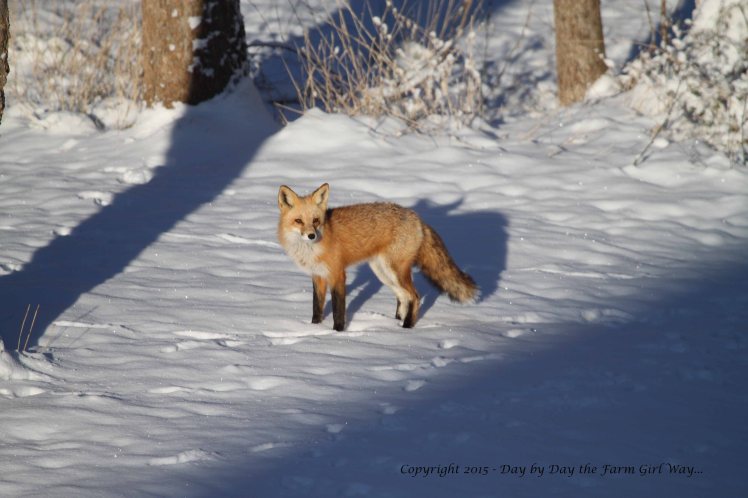
This past winter, I noticed a pair of red foxes frequenting our woodlands. One fox appeared to be old with lighter coloring and the other seemed young with a beautiful red coat and black legs. Often, one or both could be seen eating deer feed from the trough below our back porch. In the early morning as I walked in the dark to open our front gate, I often heard the raspy bark of the foxes. I knew they mated in late winter and early spring, and I hoped this barking was not a mating call. I did not mind the foxes presence over a week or two, but I sure did not want them setting up housekeeping here for the long term. I had just released our orphaned squirrels, Punkin and Mr. Gambini, and did not need the worry of foxes preying on my inexperienced kids!
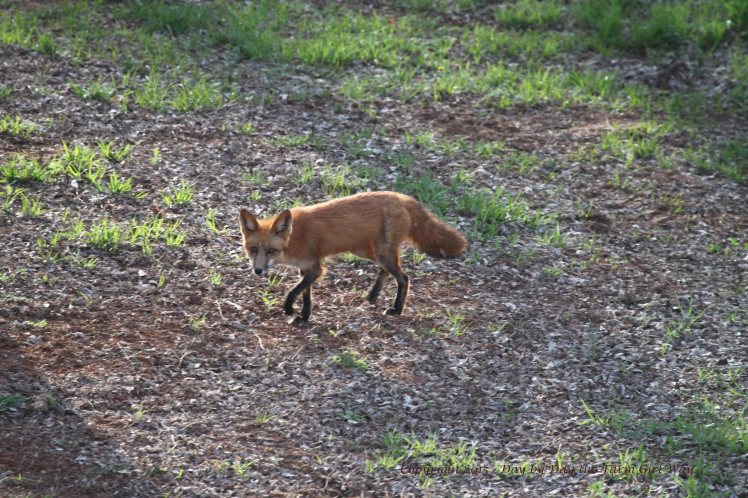
Much to my dismay, about the same time Daisy deer was setting up her nursery on the top part of our neighbors property to the north, I soon realized the foxes had the same thing in mind for the thicker woods down below. All hours of the day and night, the pair could be seen on the hunt for food. I guessed they had kits somewhere nearby but, with all of the rain we had in the month of May, I had found it impossible to walk the woodlands to try to locate the den site as I had other years in the spring. With all the moisture, the mosquito population was unbearable, so there was just no way I was going to track the foxes without finding misery in the woodlands.
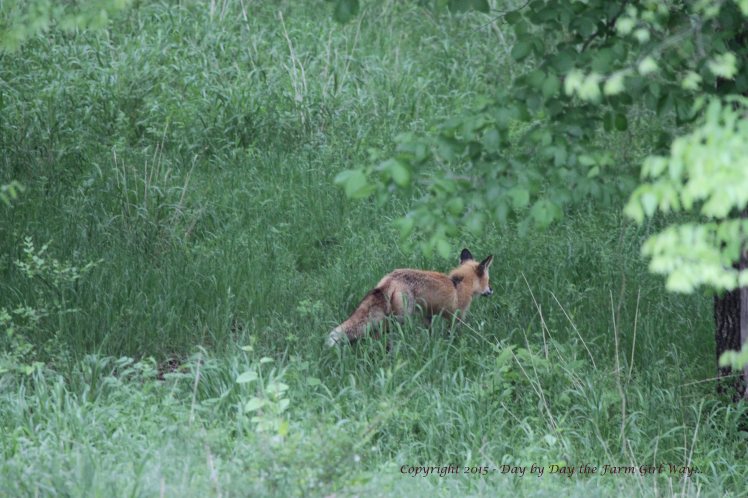
Over late spring and early summer, we observed the pair of red foxes hunting both on our property and our neighbor Steve’s property. We even heard reports from neighbors quite a distance to the west, that they had spotted them on their property as well. I wondered how many kits they were feeding, and why Daisy did not seem to mind them being around. She did send them packing if they happened into the area where Daisy had her fawns but, for the most part, she did not seem to consider them much of a threat to her young. I wondered if this was because both foxes were fairly small and rail thin, hardly any larger than Daisy’s fawns.
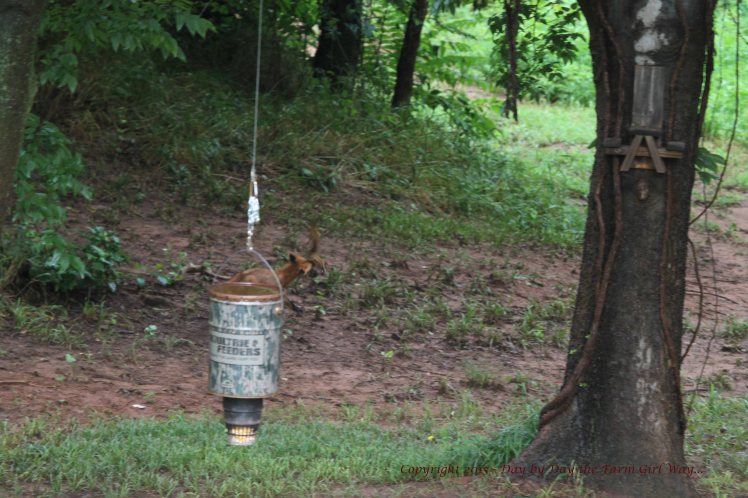
Finally, in mid July, we began seeing two kits. Just before dark each night, we observed the cubs ducking from under my mother-in-law’s sleeping cabin. The one-room cabin, sitting on blocks, had been problematic over the years as the space underneath was easily accessed by varmints of all sorts. Skunks had taken up residency there last autumn, which rendered the cabin unsuitable for guests to stay in. But apparently, the foxes found it just fine for their new digs.
Most evenings, FD and I watched the little ones play from our front porch. They raced and played around the barns and fenced gardens. But, after a couple of weeks, we noticed the pair beginning to work on their hunting skills. The young, mother fox watched them from our neighbor’s back yard as they pounced at their prey, leaping and chasing bugs in the twilight. I knew that Punkin and Mr. Gambini were well-seasoned at the business of being cautious squirrels, but by now we had just released a new pair of orphaned squirrels, Buddy and Francesca, who were still very small and inexperienced. I hoped it would be a long time before the two fox kits honed their hunting skills…
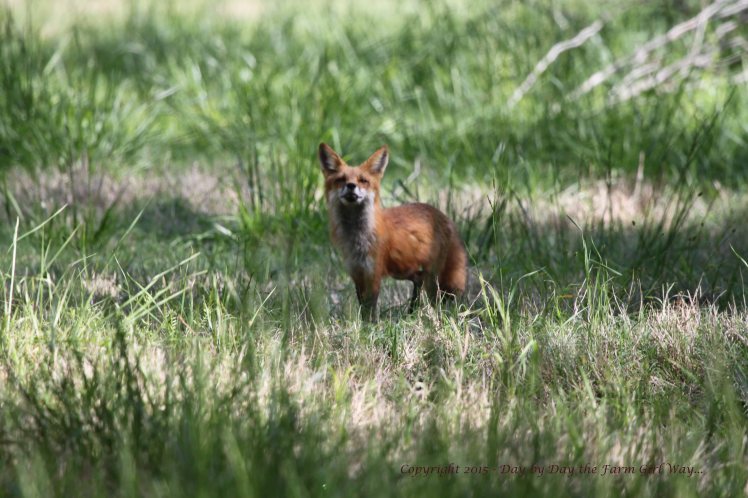
Foxes are well known for leaving their scat in obvious places, especially on a path or other prominent location, as a territorial marker. So in no time at all, we had fox scat everywhere. My mother-in-law got the worst of it – the ropy segments with tapered ends, made up of hair, teeth and sometimes insects and berries, showed up on her back porch steps, walkways and, most alarmingly, right in front of the entrance to the chicken barn! We found the fox scat in various places on our driveway and sidewalks and, of course, dotted all along the buggy trail through the woods.
And then odd items began showing up in the yard and pasture. I found odd bits of trash and plastic under trees. A couple of times, I ran across leg bones from mammals too large for a fox kill, left out in the open pasture. I could not help but wonder if they were the remains of Daisy’s fawns. Perhaps the foxes found the bones and brought them back to gnaw on them closer to home. Then one morning, one of my brand new flip-flops went missing from our front porch. I suspected the fox kits. I had read somewhere that, like dogs, foxes like chewing on things that bear a human scent. I looked all over for my flipper that week… but to no avail. Likely, one of the kits drug it under Mom’s sleeping cabin.
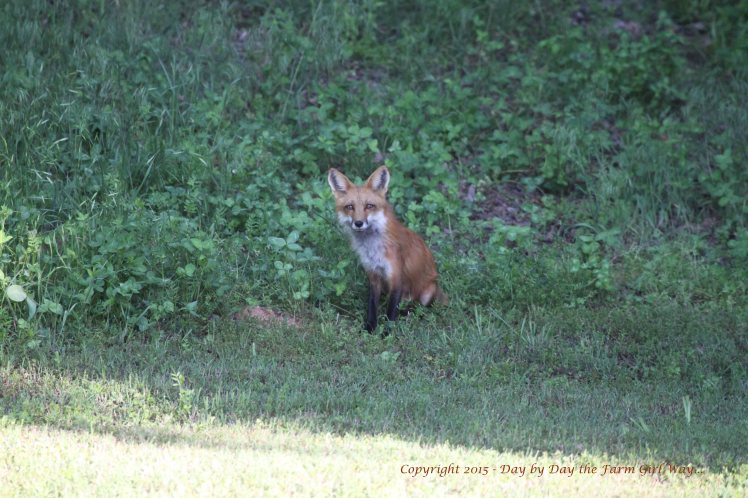
This past couple of weeks, the fox activity came to a screeching halt. I had seen the older fox only a very few times in the last weeks, but now I was not seeing the young mother or her kits. In a way, I was thankful they were gone. It had been a constant worry all summer that the squirrels we raised would be snatched up by these foxes. And frankly, I was tired of all of the scat laying around. And, I was still a bit hacked at the loss of my brand new flip-flop.
Then today, FD came in from mowing the pasture and asked me to come out and bring the camera. Just in front of the tractor, I saw what was left of the old fox. It had been two weeks since FD had last mowed the pasture grass, and what FD found today was not there then. Apparently it had not taken long for the carcass to decompose in the summer heat. All that was left were bones, a little hair, the paws, and a scraggly but definite, fluffy tail. The old fox remains looked small, a bit larger than a cat. It lay in the soft grass, not far from the area of the pasture where I had watched it run in the purple henbit blossoms in the spring. It was positioned as if it had just fallen over and died, out in the open underneath the summer sun. Life had come full circle for the old fox, and looking down at what was left of him, I could not help but wonder if, perhaps in another lifetime, he would be running wild and free again sometime soon…
© 2015 Day by Day the Farm Girl Way…
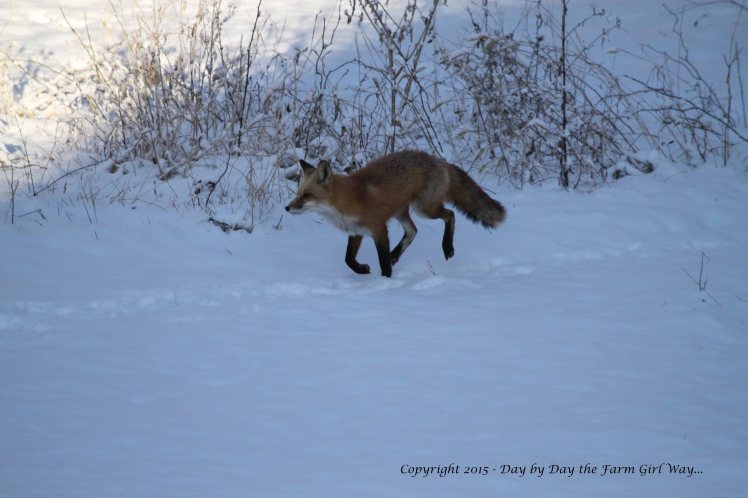
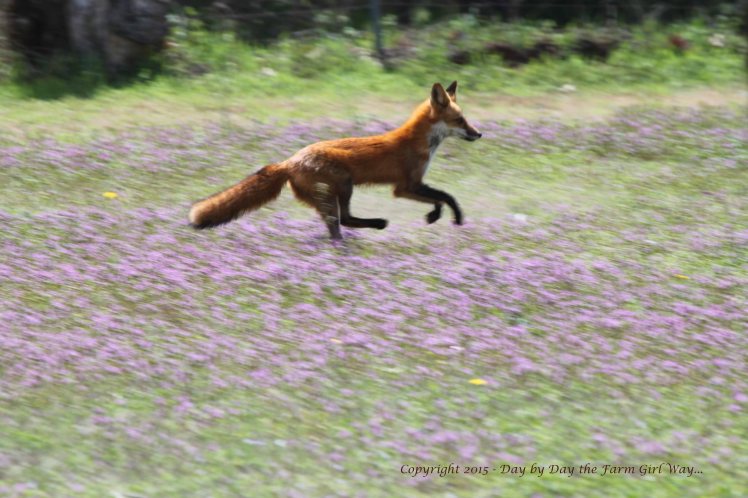
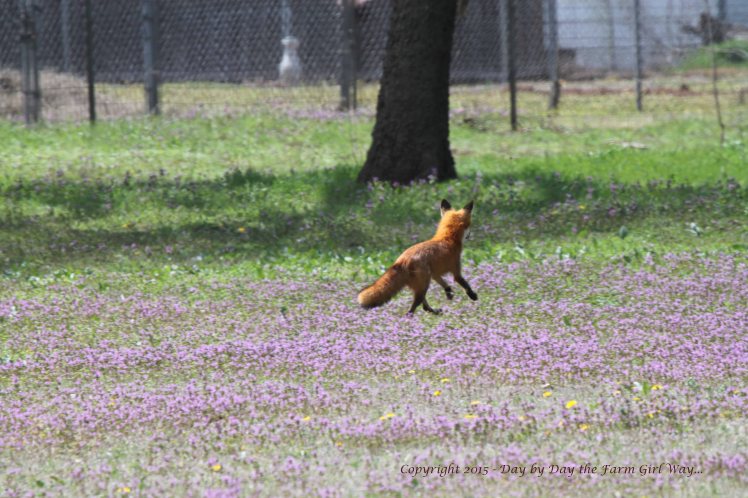
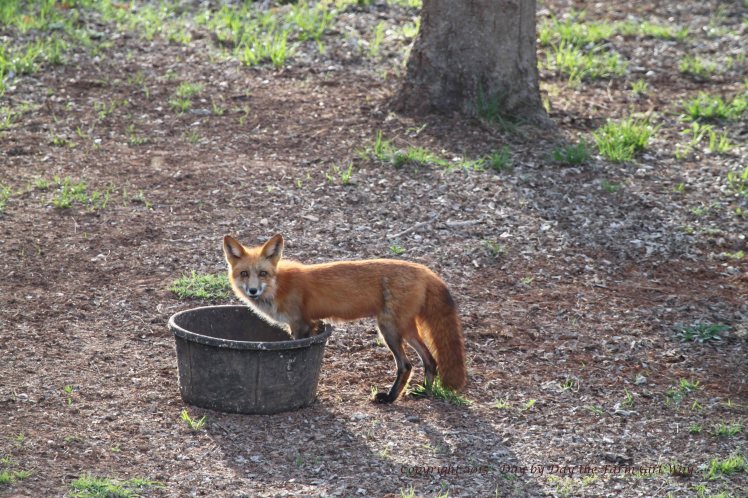
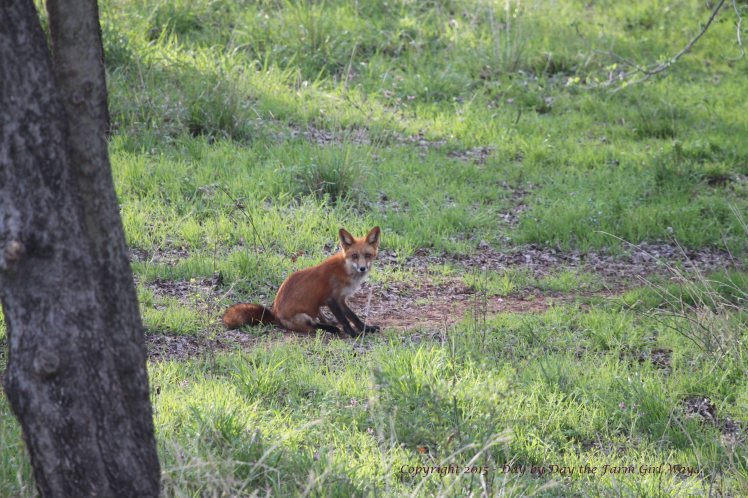
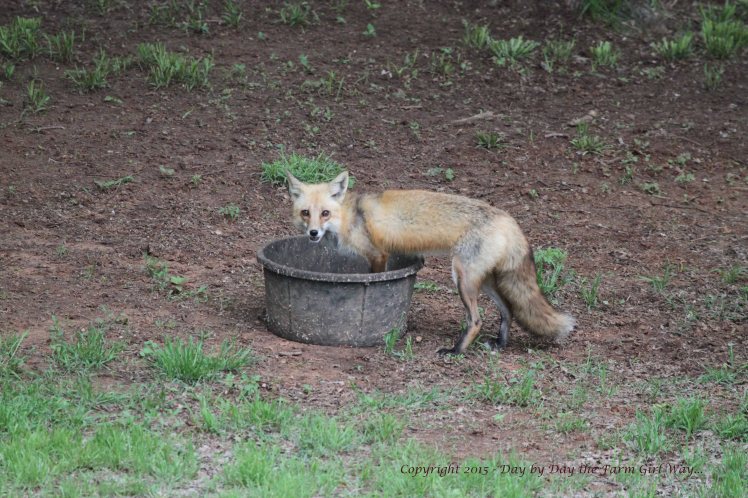

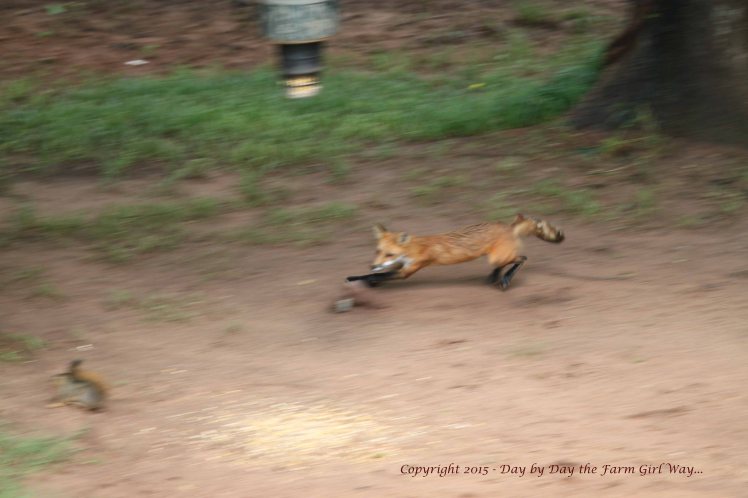
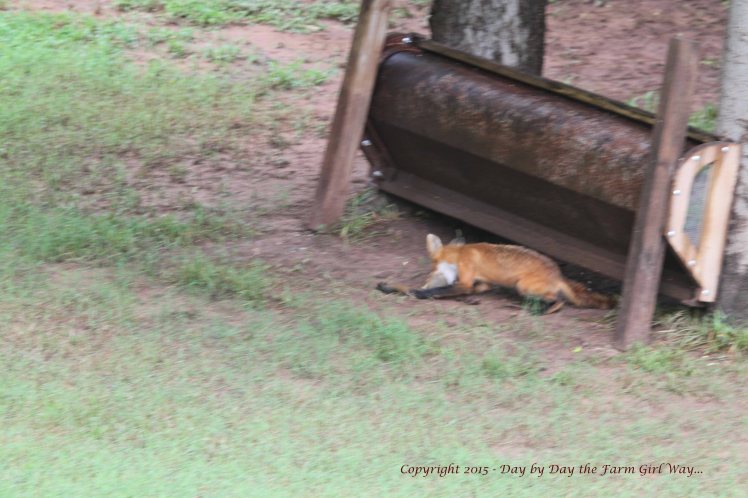
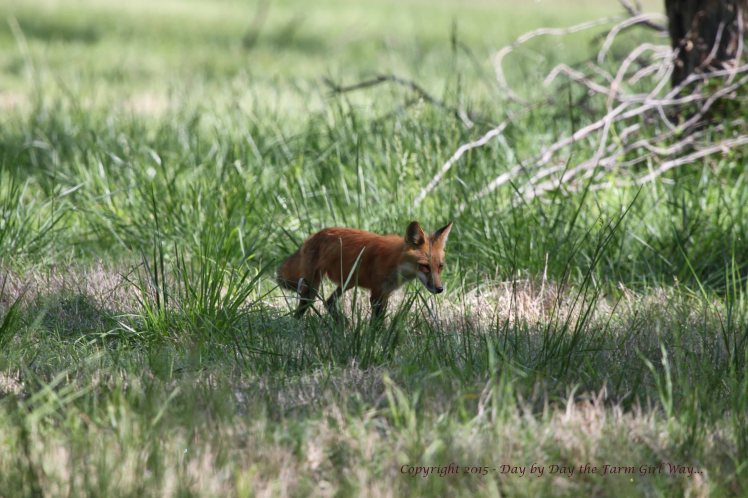
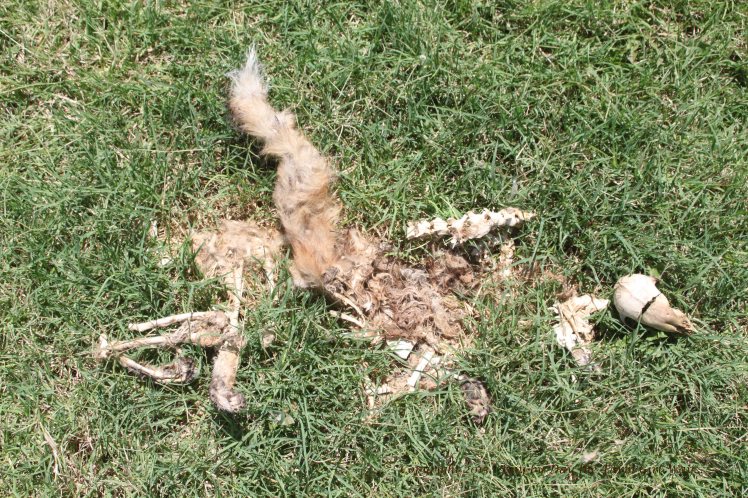
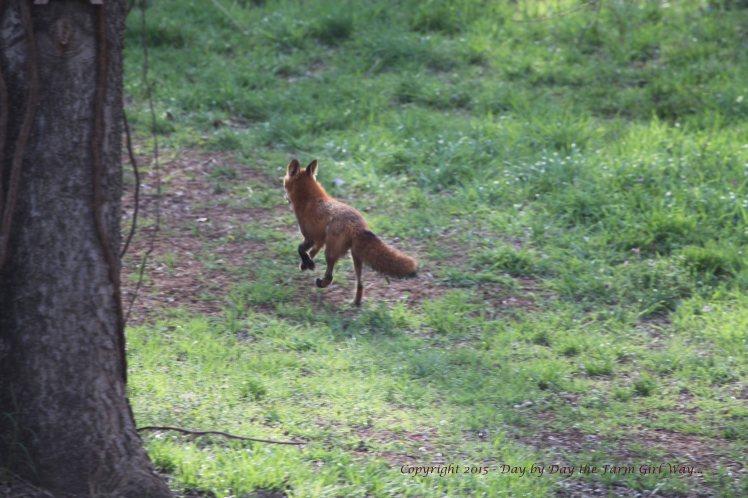
Reblogged this on By the Mighty Mumford and commented:
FOXY PHOTOS!!!!!!!! 😀
LikeLiked by 1 person
Thank you, Jonathan… I am glad you enjoyed this post. 🙂
LikeLiked by 1 person
So remarkable how much of the natural world you witness on a daily basis, how immersed you are in it. A modern day nature writer – more John Boroughs than Thoreau, perhaps. . Find myself wondering if you have ever read “Pilgrim at Tinker Creek” by Annie Dillard? Or, this one might be so like you, in observing the web of life – “One Day at Teton Marsh”, by Sally Carrighar?
LikeLiked by 1 person
What a kind observation, Cnawan. I often wish I was more “immersed” in nature… and I am able to be moreso in the fall and winter months. I will put those books on my “to read” list. Thank you for suggesting them! I keep wondering if I will have more time to read when I “retire”… if there is such a thing!
LikeLiked by 2 people
You really MUST read Pilgrim at Tinker Creek. I’ve read it at least a half-dozen times in full, and often dip into it. She has your sensibilities, and a lot of good, practical advice about interacting with the natural world, too.
I hate the thought of the old fox dying in such a way, but it is the way of the world. The circle of life goes on…
LikeLiked by 2 people
That does it! I’m ordering the book since it has gotten rave reviews here! I am still a bit sad about the old fox. I have the brush (tail) and the skull on the front porch. There is still a bit of smell to it, so I hope nothing drags it off. I am always amazed at how small the skeletal structure is of many of the wild critters. I guess the hair or fur often gives them a bigger appearance.
Thank you for your always, nice comments!
LikeLiked by 1 person
Awesome! ^ get the book!
LikeLiked by 1 person
If “retirement” is the discontinueing of doing meaningful work, then no, no retirement for you. One sees you innately following your passions for as long as you can. 🙂
LikeLike
My goodness you are able to watch an incredible array of animals in your neck of the woods Lori! SO many animals hang around and go through their life cycles close to you. You can never say that you lead a boring life, that’s for sure. I felt like I knew that old red fox. I am sorry that he died but I am also sorry that the squirrels died as well (and very glad none of them were your babies). Again, another lesson in life, told from the sidelines. You should have a newspaper column Lori 🙂
LikeLiked by 1 person
As I was looking back through photographs of the foxes over the past months, I found so many photos that were other stories I need to tell yet. Fran, it’s endless here – what we see and experience with wildlife. There are messages all around from nature. And yes, if I took the time to post daily, it would be somewhat of a newspaper to read, so to speak. What is amazing about people in small communities especially, is that nature is all around – just down the street or in their own backyard. Daisy can be standing at the fence near the street and people walking, riding bicycles or traveling via car completely miss seeing her. Very few folks stop to look or take a minute to observe her. I’m afraid we miss the boat by being too busy most of the time. And we miss the messages from nature. The Universe speaks continually…
LikeLiked by 3 people
I think people living in cities like to hear this kind of thing Lori, it reminds them that we are all supposed to be living on the coalface of nature and it gives them a sense of place 🙂
LikeLiked by 1 person
Of course people must also realize this spraying of herbicides and pesticides in town kills off the food source of many wild things. It is all about appreciating every living thing isn’t it?… and living with our eyes wide open! 🙂
LikeLiked by 1 person
Such wonderful photos following their story!
LikeLiked by 1 person
Oh, thank you so much!! 🙂
LikeLike
Thanks for sharing this story….the circle of life. There is another rehabber that I am working with that has a pair of gray foxes that will be released soon. So it is interesting to follow your observations. I hope to be there for release day and capture it on photos. But what you have taught me, is that they need to be released far from folks and any animals that have been rehabbed.
LikeLiked by 1 person
Excellent thoughts, Yetta! It is always good to do a little research also to discover all there is to learn about habitat and behavior of wild critters before release. Normally the way we release squirrels would be no problem, but observing the foxes did make us think about where our water tub is (we had to trim back tall grasses near it as the foxes hid in it making it easy to nab birds and squirrels getting water), and our feeders. There was little to do about some species, like doves, who spend a lot of time on the ground. We lost a lot of doves this year. 😦
LikeLike
As always, your wildlife photos are exquisite. Thank you for telling your story. Foxes are beautiful and seldom seen.
LikeLiked by 1 person
Thank you… I am outdoors a lot or looking out of my kitchen window many times when I spot wildlife. I keep my camera handy most of the time! The foxes are so interesting to watch, especially the jumps and leaps in catching insects… or to watch them patiently listen to the sounds underground, and then dig and pounce on a varmint (gopher or moles). You are correct, we do not see foxes much, but I think this year with kits to feed, they had a reason to be seen all hours of the day and night. Both the old and young fox were rail thin by mid summer. As is with most wild critters, the parents are thin from working to feed the young and the young are fat and sassy!!
LikeLiked by 1 person
We’ve had a fox in our backyard from time to time. We don’t see them often though and it is rare to see more than once or twice a season. They are fast. We always scan the fenced in backyard before letting the girls outside.
LikeLiked by 1 person
Oh Dan, I’m with you – I watch our three little dogs like a sentry when I let them out. Little Zoe loves to be outdoors with me but I haven’t had her outdoors much at all this year simply because she is small and would be tempting to a fox for lunch!
LikeLike
Great post. Amazing photos. 🙂
LikeLiked by 1 person
Thanks, Paulette! 🙂
LikeLike
Great pics. Were you sad to see that the old fox was dead, even though he was a threat to your adopted ‘babies’?
LikeLiked by 1 person
Thank you, Henrietta. Yes, you know me well. I was very sad when I observed the bones. Even though the fox is a predator, it is also a beautiful creature that has a place in nature. I kept the tail (called a “brush”) and the skull. I was amazed at how the carcass just melted into the grasses and how small the skeletal frame was. I felt sad, but I also knew the old fox lived a good, long life. I walked away thanking him for sharing his life with me.
LikeLike
Do you know how fascinating this post was to read? Again your photography was amazing to see. The circle of life exemplified and wonderfully composed as always, Lori.
LikeLiked by 1 person
Oh, thank you, Lynda! One day soon you will be weaving your own stories of the wild things at the Mountain Farmlet and I will be smiling, knowing you are bonding with nature so closely. It is an amazing experience. Just remember to keep your footwear, hats or gloves off the open porches!! 😀
LikeLiked by 1 person
I loved reading this story! I was thinking you’d make a great children’s book author! And your photos would make great illustrations!
LikeLiked by 2 people
Thank you! That is what I am leaning towards… though I need to cut out a lot of my ranch work in order to make that commitment! 🙂
LikeLiked by 2 people
I was totally entranced by your account of the foxes. I saw a red fox here in the early morning a few months ago. They probably help keep the rabbits under control, which are a huge nuisance here, but even a bigger nuisance are feral cats, which the foxes probably don’t tangle with. I’ve learned so much from your account of the natural world around you. I started Pilgrim at Tinker Creek a few months ago and got distracted but was just thinking yesterday I would pick it up again. Based on recommendations here, I can hardly wait. Thank you Lori!
LikeLiked by 1 person
Thank you, Ardys! You always make me feel so good with your comments. I am ordering Pilgrim at Tinker Creek tonight. I think I have three different books going right now. This time of year I get easily distracted, but come fall and winter when my outside activities slow down, I can devote more time to reading and writing. 🙂
LikeLiked by 1 person
Dear Lori,
Once again you delight us and have us hooked with your keen observational skills and wonderful story telling abilities. I can really see these compiled into a book. Your photographs beautifully illustrate your narrations too. It’s very difficult finding the time when you have so much to do on the farm though. I can understand that! When I lived on farms, there was always so much happening, planned and unplanned. With animals about, you never know what will happen next!
Foxes are an introduced animal here and do a lot of damage to native wildlife although it seems that feral cats do the most damage according to recent research. They are beautiful looking animals and it is hard to think of them as ferocious predators but like you I’ve watched them in action. They are fast and that shaking action is deadly. I found a fox caught in a rabbit trap set by a neighbour once and to see the snarling terrified creature jumping about and showing its sharp teeth was a shock. I had an ongoing “interesting” relationship with foxes out west, as they quite liked the taste of my free range turkeys and chickens and they would kill newborn lambs. They were just hungry but it didn’t stop me calling them a few names on occasion! I know they are only doing what comes naturally to them though. 🙂
LikeLiked by 1 person
Jane, I always enjoy your reflections of past experiences with various critters! These foxes have really made a dent in the rabbit and squirrel population around here. I think my mother-in-law fears they may attack her chickens, and she should worry as her barn and fenced area are quite dilapidated! We already saw Ms. Foxy (could have been the current young fox) eating one of Mom’s roosters last fall. Once they get a taste for something, they’re relentless!
We have trouble with feral cats here too, and oddly nothing seems to touch them. I think because feral cats carry so many diseases perhaps other wildlife know this instinctively. Daisy will hoof them off when she has fawns around. She takes off after them with a vengeance so perhaps she is onto the dangers they pose.
We use a few choice words and names at times around here too. I think that’s common all around the world!! Ha ha!
LikeLiked by 1 person
We have them around us. They are extremely beautiful animals. We haven’t seen as many lately, but there are a lot of coyotes in our area at this time. Coyotes with hunt down – and eat – foxes.
LikeLike
I’m sorry about about Mr. fox:( Nothing worse than those love, hate; relationships.
LikeLike
Oh, I know, Jonie! But never fear… today we noticed one of the kits is hunting the area. Rats. I was hoping the whole family had moved on. 😦
LikeLike
Sad as it is, these ‘relationships’ in the wild are – WILD! But, more than that, it’s your narrative that makes this piece so HUMAN! By the way, Tyson’s had his first ‘kill’ of the season – sadly it was a kitten.Thankfully, there’s nothing more than a dog here – so, for now, Tyson’s safe 😉
LikeLike
Yes, Mandeep, even our “domesticated” animals have wild instinct and cannot be blamed for what they often do. We have a lot of feral cats around here… too bad Tyson is so far away – he could get our cat population under control!! 🙂
LikeLiked by 1 person
And the Big Wheel keeps on turning. Thanks for another great post, Lori!
LikeLike
Thank you, Monica!!
LikeLike
Lori the photos are excellent and such great documentation. I think the fox are gorgeous creatures but as you have written they’ll wipe out the rabbits and squirrels. I hope they don’t stay at your MIL’s place from now on. Maybe something will cause them to move on but maybe not.
There are fox in my area, I’d see them running down the lane in front of my vehicle when ever I came home from work around 12:30am. But Id rather they not be around, I don’t see them anymore since I retired but this is a semi-wooded area and I know they are here.
LikeLike
Yvonne, you are correct about foxes acclimating quite well in the suburbs and semi-wooded neighborhoods. I think they feast on cat food and trash. I often see the young fox make her way to the neighborhood east of us. And, I notice they hunt both day and night. I see them mostly in the mornings up until about noon and then again at dusk. I believe they are no longer at my MIL’s but somewhere just south and west in our woods. I often see them off in the pasture and they come from the west. We don’t have enough in our corner of the woods to support the three of them for long. I believe they will move on before long. Perhaps the mother is waiting until her cubs are more proficient at hunting to head on towards the river area.
LikeLiked by 1 person
Lets hope that she does move on. I know you will be relieved, if she does.
LikeLike
Hi Lori. Whilst foxes are an introduced animal to Australia and have had a devastating impact on the native wild life, I can’t help admiring them. They are handsome creatures and very resilient adapting to both urban and rural environments.
I have seen them in the midst of suburbia as well as on farmland and in the bush. Most recently, I saw one in the bush. It backtracked as soon as it became aware of the presence of myself and Katie.
LikeLike
Aren’t foxes just breathtaking, Margaret? They are not often seen, so you are fortunate to have been able to observe that one in the bush. I am lucky to see the young fox and her kits a good bit again. They disappeared for about a week, then they were back. I guess the hunting must still be good here and they are somewhat protected this close to town. I often see the mother trotting into the neighborhood to the east so I’m sure she gets cat food this way. My next-door neighbor, Steve, saw one of the kits trotting off with his cat bowl the other day!! How funny.
LikeLike
Foxes have always intrigued me. Like formal little gentlemen all dressed up for an event. We had one that ranged near our old house which backed up to a pasture. Eventually the family moved into some brush on a golf course once the land was sold and became a neighborhood. You’d see the big male trotting down the esplanade of the boulevard…wouldn’t have been surprised if he nodded and said “Good day.” as he passed.
Sometimes we’d run across bodies of cattle, or critters on the farm. Their bones are so sculptural – real art work.
Live free, little ones.There are those who will shield you as much as they can – just because it’s the right thing to do
Lovely story and ethereal images
LikeLike
Oh my! You described the dapper fox perfectly! They are quite interesting to observe. Those leaping and pouncing acrobats are sure to keep your attention! I notice they stop to scratch a lot – fleas no doubt. Of course the young mother fox and her kits are back. I guess the squirrel population we have here is just too good to pass up. I still hope in time they move on to greener pastures. Yesterday I saw all three of them basking in the morning sun on the edge of the woodlands. Red coated beauties all of them! Thank you so much for your wonderful comment!
LikeLiked by 1 person
This made me sad. Well written friend, enjoyed.
LikeLike
Thank you, Amy. I’m sad too. All of these critters that frequent the woodlands are special to me… but I sure wish I had my missing flip flop back! 😀
LikeLike
I have seen a fox only once, crossing a gravel road in the Minnesota River Valley. It was beautiful. But I can understand how you would view fox as a nuisance given their behavior and scat deposits. You’ve taught me a lot in this post.
LikeLike
I guess you see from the comments that the young fox and her kits have returned. They truly are beautiful and clever creatures. I know they will move onto greener pastures in time, but I miss the rabbits and I worry about the little squirrels we have raised. Of course I can always manage to find things to worry about here! 🙂
LikeLike
I’m sad too for this farewell, I wish this post had been happier…
LikeLike
I know, Lily… it is sad. However, this past week the young fox and her two kits are back. They were having a playful frolic in the pasture in the morning sun. So, there is new life in the woodlands. 🙂
LikeLike
Sorry to hear about the old fox passing away…beautiful post and photographs!
LikeLiked by 1 person
Thank you, Josie. The mother fox and her two kits are still here. I wish they would move on. They are taking a toll on the small mammal population around here. 😦
LikeLike